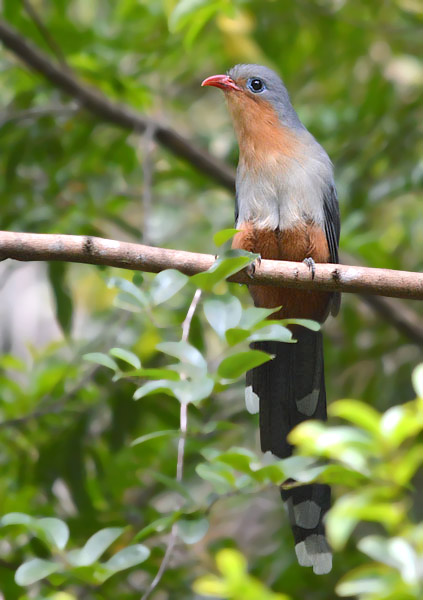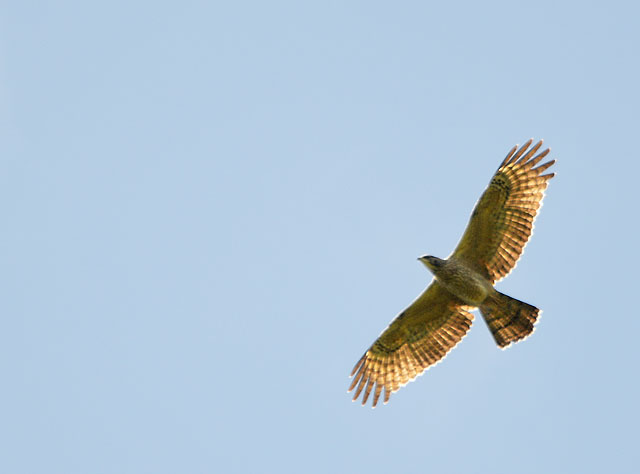Brothers
Nigel and Jimmy are regular guests of mine whom through the years, have become
friends. We certainly have our share of birding excursions in far off lands. In
fact plans are being made for another birding adventure next year and if it
materializes, it would be my biggest birding trip ever. Anyway, closer to home the
brothers were back in Penang for a family holiday and they managed to allocate
a day for birding. One of their targets this time was the Scaly-breasted Bulbul
and I knew exactly where to take them for this striking forest gem. Upon
arrival at the forest surrounding Pedu Lake in Kedah state, we were greeted by
sunny blue skies and that is a somewhat rare commodity these days. Then and
there I had a very good feeling about today’s trip and my gut instinct was
right on the money as I was about to find out.

The
fruiting tree was still in full swing and birds were diving in from every
corner. It did not take long to locate the first Scaly-breasted Bulbul.
Everything about the bird’s appearance shouts attention and it certainly had
ours. A little patience yielded better photographic opportunities as the bulbuls
started to wander lower down to forage. The
lighting condition today was such a stark difference from my last visit here a
few days back. Naturally, the images revealed more of the bulbul’s true
splendour. I was feeling elated although the Scaly-breasted Bulbul is not new
to me. My guests, were overwhelmed.


When
we could finally break ourselves free from the hold these bulbuls had on us, we
took a slow walk along the access road seeking more denizens of this lush
landscape. The grassy patches along the edge of the forest are frequented by the
rarest munia species in Peninsular Malaysia. Pedu is the only one of my regular
birding sites where the White-bellied Munia is recorded. I could hardly
contained my excitement when we came across a small flock right next to the
road. The dense vegetation made it frustratingly difficult to obtain unobstructed
views. After many attempts and streams of profanity later, one member of the
flock alighted on an exposed perch to soak in the warm rays of the morning sun.
There was a small gap in the vegetation to allow me my moment of glory and that
was more than I could ever wish for.

Nowadays,
every Ashy Minivet that I encounter will be given its due attention to ensure
that I do not overlook similar but much rarer species. There was nothing
unusual about this female Ashy Minivet but she did provide a stellar
performance for this group of visiting birders.
A
trogon perched at eye level got my imagination running wild and almost had me
believing I was staring at the highly sought after Cinnamon-rumped Trogon. But when
reality took back the reins, there was no denying the presence of red on the
rump. The Scarlet-rumped Trogon may be the most frequently encountered species
but it has enough finesse to brighten up any birding excursion. Not that today’s
excursion needed any brightening.
Not
quite as appealing as the trogon, the Streaked Bulbul still deserves some
recognition as it not a common species. It does not usually patronize fruiting
trees and prolonged encounters like this one will not go unappreciated.
During
my last visit here, our group had an exhilarating encounter with a Giant Forest
Scorpion. Today, it was a Spider Wasp living up its namesake. This skilful
hunter has just caught a spider of similar size and was dragging its prey off
into the forest. Pedu never ceases to amaze.
Raptors
were certainly up and about today and I bet it had a lot to do the sunny
weather we were enjoying. The first of these predatory birds to cross our path
was a Crested Goshawk. It is a beautiful raptor and here in the north, we are
not blessed with many encounters. What did I tell you about my gut feeling in
the beginning of this post?
The
far carrying territorial calls of the Crested Serpent-Eagle echoed through the vicinity
on more than one occasion. However, this common but still impressive raptor did
not get down low enough for any memorable shots.
Today,
the Oriental Honey-Buzzards were everywhere. It is a little late in the season
but they still appeared to be on migration. A flock of 5 buzzards taking full
advantage of the rising thermals gained our undivided attention.
As
we were enjoying the small spectacle, I swore I heard the cries of a Blyth’s
Hawk-Eagle. Upon further observation, one of the ‘buzzards’ looked a bit odd
and when it took a swoop at a nearby comrade only did I realized it was the
Blyth’s Hawk-Eagle that I heard. The concentration of Oriental Honey-Buzzards
must have hit a nerve and the eagle took matters into its own wings. The
Blyth’s Hawk-Eagle was the fourth and final species of raptor to make an appearance
during our visit here.
However,
the bird of the day at this site do not rule the skies. It is a docile dweller
of the canopy levels with a combination of vibrant colours that makes it one of
the most alluring species in the tropical rain forest. The Red-billed Malkoha
is not a rare species here and when one is privileged enough to encounter it
foraging along the lower levels, it will be a memorable experience. It is not a
particularly shy bird but has a knack to stay partly hidden by the vegetation.
Today
was indeed our lucky day because it alighted on an exposed perch during its
foray out of its comfort zone and for that brief moment, time came to a
complete standstill. We found ourselves lost in this Red-billed Malkoha’s
mesmerizing beauty. Life can be beautiful at times.
The
next location we visited was the mangroves of Sungai Batu and the resident
White-breasted Waterhen was the first to greet our arrival.
Inquisitive
as ever, the resident pair of Abbott’s Babbler provided some good photographic opportunities
as they moved about the vicinity.
Only
the female Mangrove Blue Flycatcher presented herself well enough for me to
photograph this time.
I
have brought the brothers to this spot before but that does not stop them from
getting all excited when the Mangrove Pitta hopped into the view. As a matter
of fact, it did not stop me either...
The
main reason for our visit to this site was for the Forest Wagtail. This
adorable migrant did not show itself during the brothers’ last visit here. Thankfully,
history did not repeat itself today and ample views were obtained.
From
the mangroves, we then tried our luck at the paddy fields of mainland Penang. We
were greeted by a splendid view of a flock of Grey-headed Lapwings resting in a
sea of green. The distance could not produce any reasonably good images but the
encounter certainly provided a moment to be cherished.
On
the next patch of paddy field, we were delighted to find a young bird resting
much closer to the access road. The afternoon light today certainly
complimented the image of this unusually confiding Grey-headed Lapwing well.
A
number of Whiskered Terns were present in the vicinity as well today. Graceful
and beautiful, it is always a joy to see them float about in search of food.
However, it is not easy to capture them in flight. A flock at rest is the best
alternative.
The
isolated trees within the paddy fields were again alive with starlings. Since
it is that time of the year again, we scrutinized the flocks hoping for some
Christmas magic. But it was not to be and only the usual Daurian Starlings were
recorded. And their memorable performance helped to ease my disappointment of
failing to reconnect with the much rarer White-shouldered Starling that I
recently photographed here.
The
Jungle Myna is relatively common here but the same cannot be said for built-up
areas on the island. Stiff competition from the other myna species are reducing
the population of Jungle Mynas as a whole in this state. There could be more
bad news as the Javan Mynas are inevitably colonizing their way up north.
The
Common Kingfisher is a regular winter visitor to the vicinity but can be easily
overlooked due to its small size. Do not be misled by the name. Although it is
not rare, it does take some luck and effort to see one in the wild. This female
bird was hunting from a clean perch at eye level and together with her lovely
plumage, made her rather conspicuous and a good subject for photography.
On
the other hand, the White-throated Kingfisher can be seen on every visit here.
It is not only due to its stunning appearance and larger size. It is by far the
commonest inland kingfisher in Malaysia. Usually ignored due to its abundance
but today I felt like paying homage to every confiding bird we encounter as a
sign of gratitude for the good fortune we have been given today – weather and
bird wise.
A
small patch of reeds next to the access road provided one of the highlights of
the trip. There was a Yellow Bittern was on the hunt and it was not the least
perturbed by our presence.
We
had to shift our vehicle midway during our observation because of an approaching
vehicle. I usually curse under my breath in times like these (although it is no
fault of the other vehicle) but this time, it turned out to be a blessing. The slight
shift produced a second bittern that was there all this while undetected. I
have seen this ‘Kungfu’ pose in the works of others and today, I finally got my
own. Bitterns can be confiding at times but today, these individuals were
amazing.
Unbelievable
as it may seem, there was a third bittern in this very spot and for the second
time today (the Oriental Honey Buzzards at Pedu and now this), we found
ourselves surrounded by the subject we so passionately seek. There was some
Christmas magic in the air after all.
The
dreadful weather that has been plaguing our lands of late finally crept up
later in the evening. For once, it was of no worry as I was about to conclude
the tour. It has been an incredible day despite the lack of any true rarities. A
refreshing difference after several trips of difficult and wet birding. The
tropics no doubt houses some of the most fascinating and enchanting bird
species in the world but the challenges will always be there and you will have
to rely on your passion to get you through.


































































